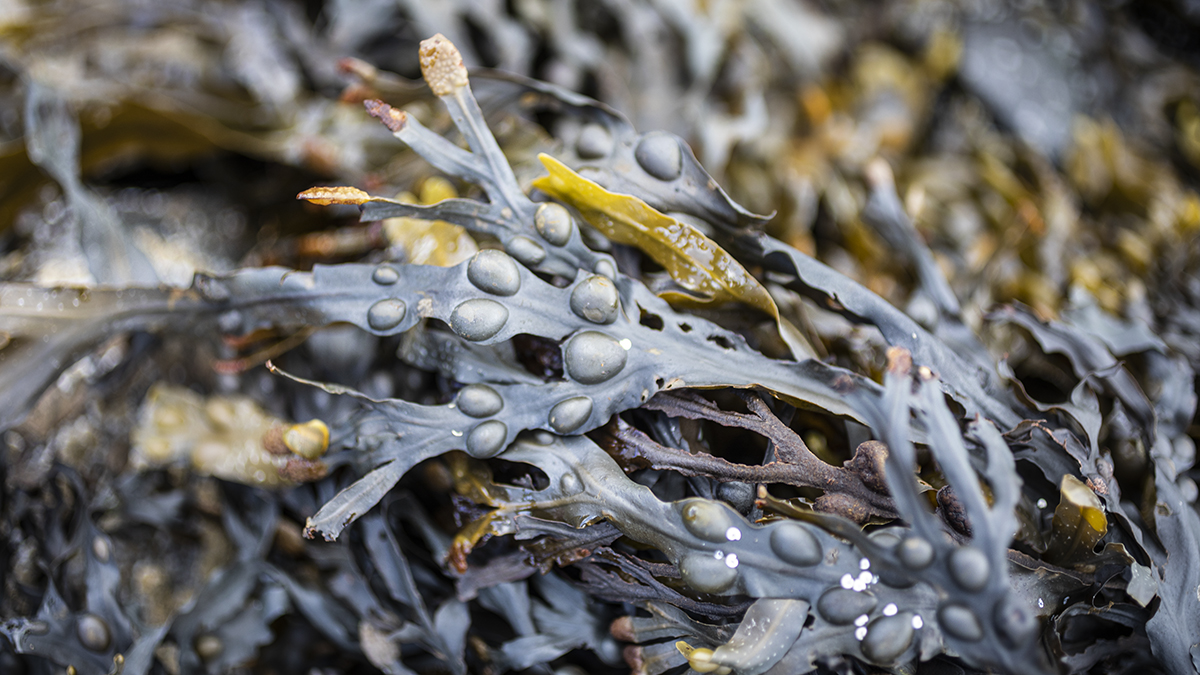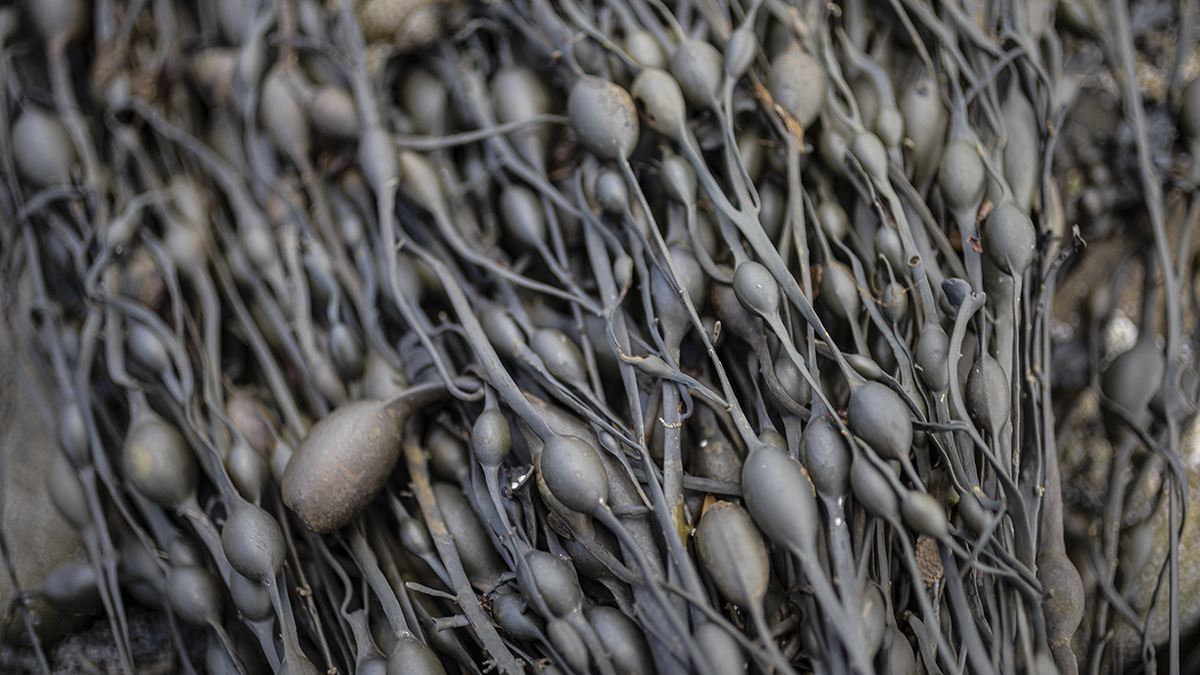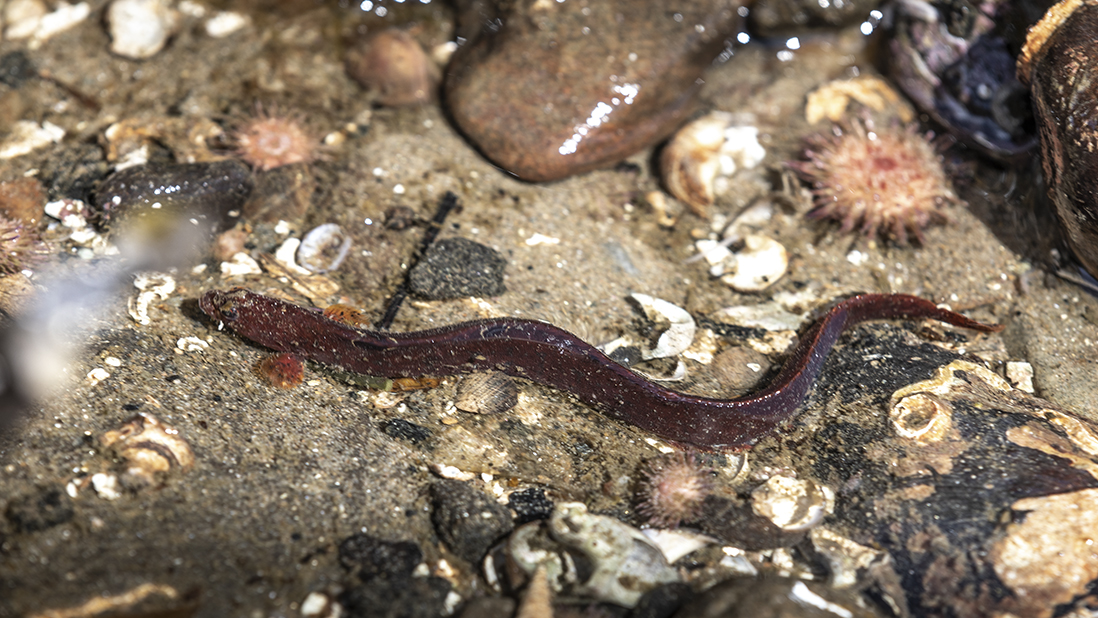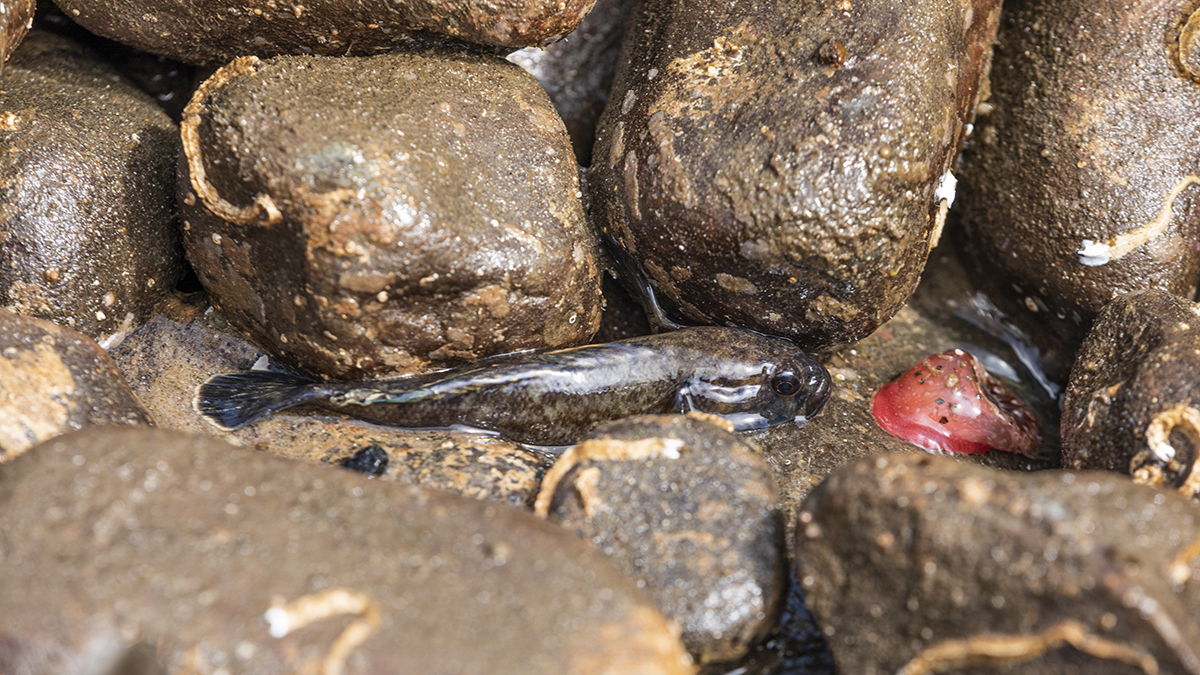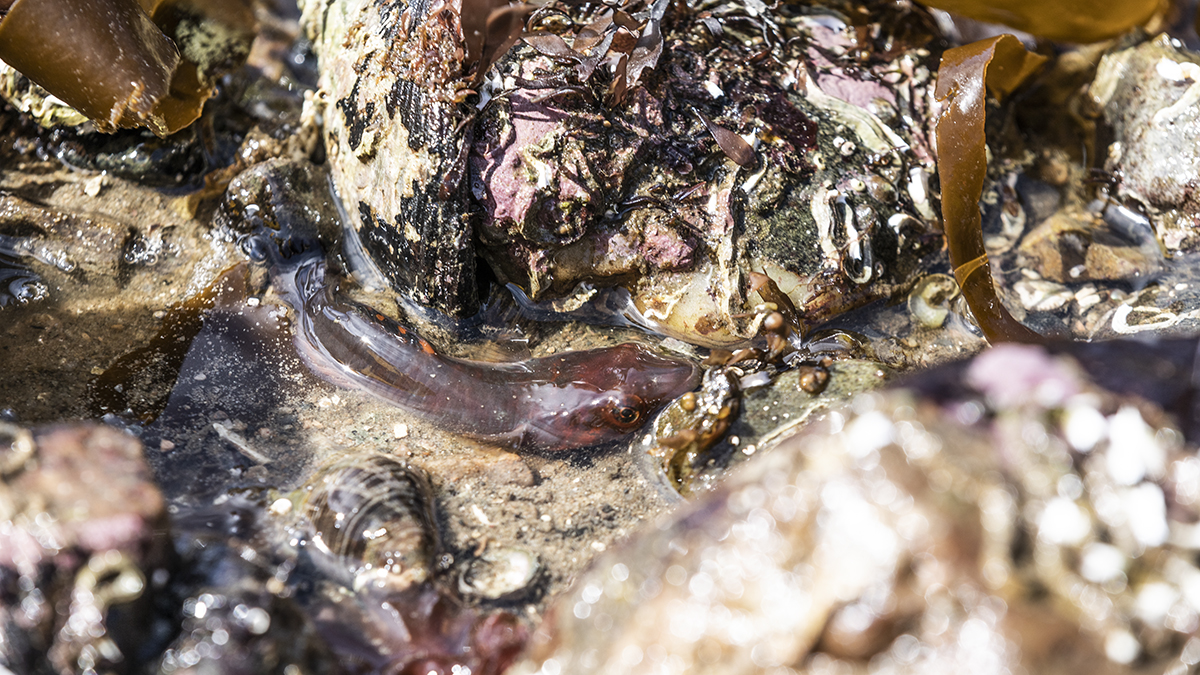A S H O R E
SEA LIFE ON THE SUMMER ISLES SHORELINES
In line with Scottish Canoe Association advice we’ve been remaining ashore. We thought we would offer some re-ashore-ance that we will be back on the water as soon as we can with responsibility to our care services, our community and our staff. In the meantime we’ll explore the wonders hidden on the beach.
If you are fortunate enough to be local to the seaside, take a look under the seaweed and the rocks and you’ll find a hidden world of natural wonder. In this blog we’ll touch upon a huge subject with a few of our favourite finds.
As always, what we move we should carefully replace it when we leave to give our coastal friends their home back.
Slippery, sloppy, slimy and stinky…we LOVE exploring between the rocks and sea weed…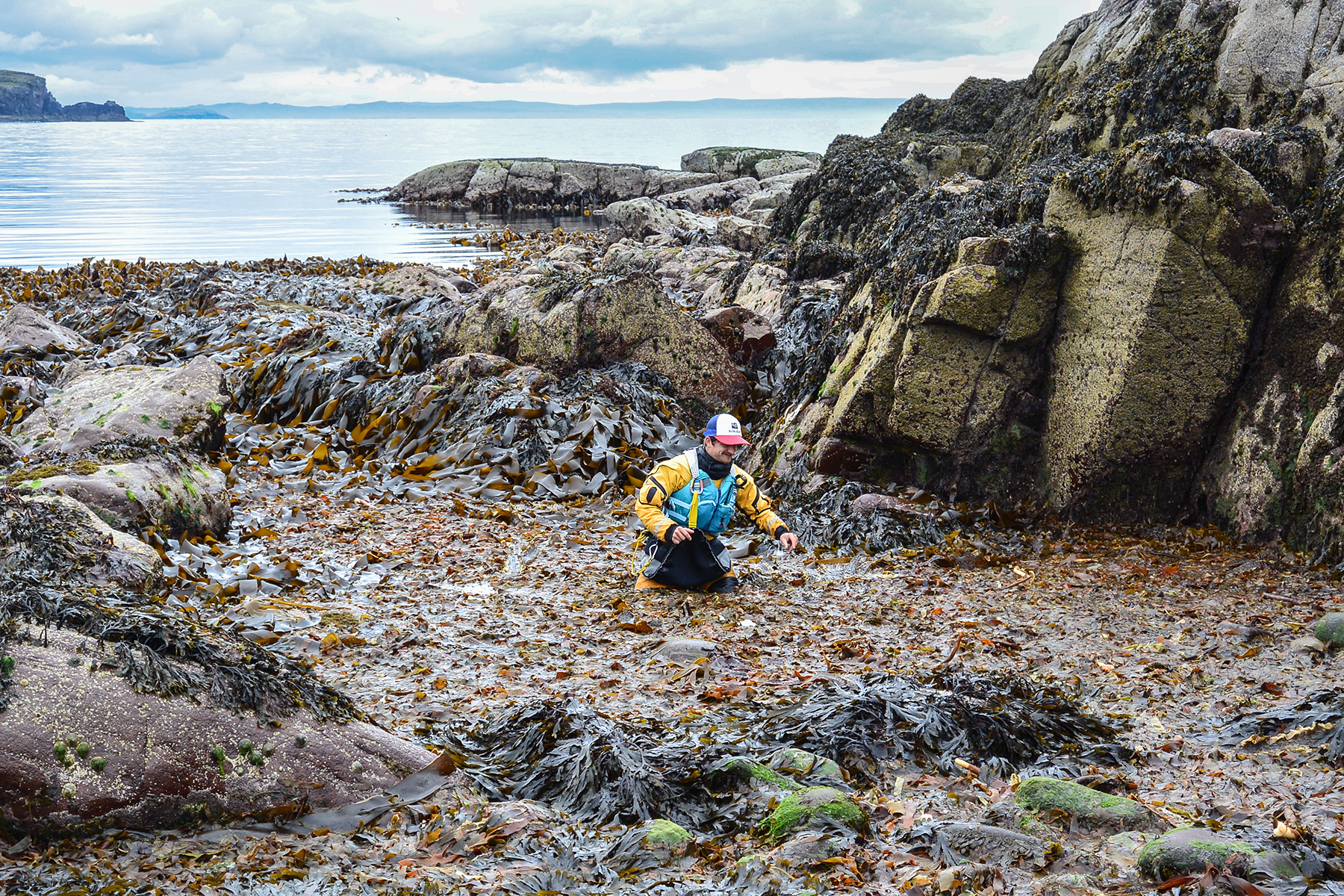
S P L A S H Z O N E
Have you ever wondered what the black stuff is covering the rocks above the beaches in the UK? Believe it or not, it isn’t often oil, it is Verrucaria maura (Tar Lichen). Common at the top of most beaches here in Scotland, we often know it as kayakers for being extremely slippery but believe it or not under close inspection with a microscope it has a cracked appearance a bit like dried mud.
Above the tar lichen are often the wonderful dashes of yellow, white and orange lichen that thrive in the occasional spray of salty water. Historically, some of these lichens were used as dyes for clothing producing colours from bright purples to deep yolk yellows. Scuttling amongst them you might find sea slaters (Ligia oceanica) running between the cracks in the rocks.
 Sea Slater
Sea Slater 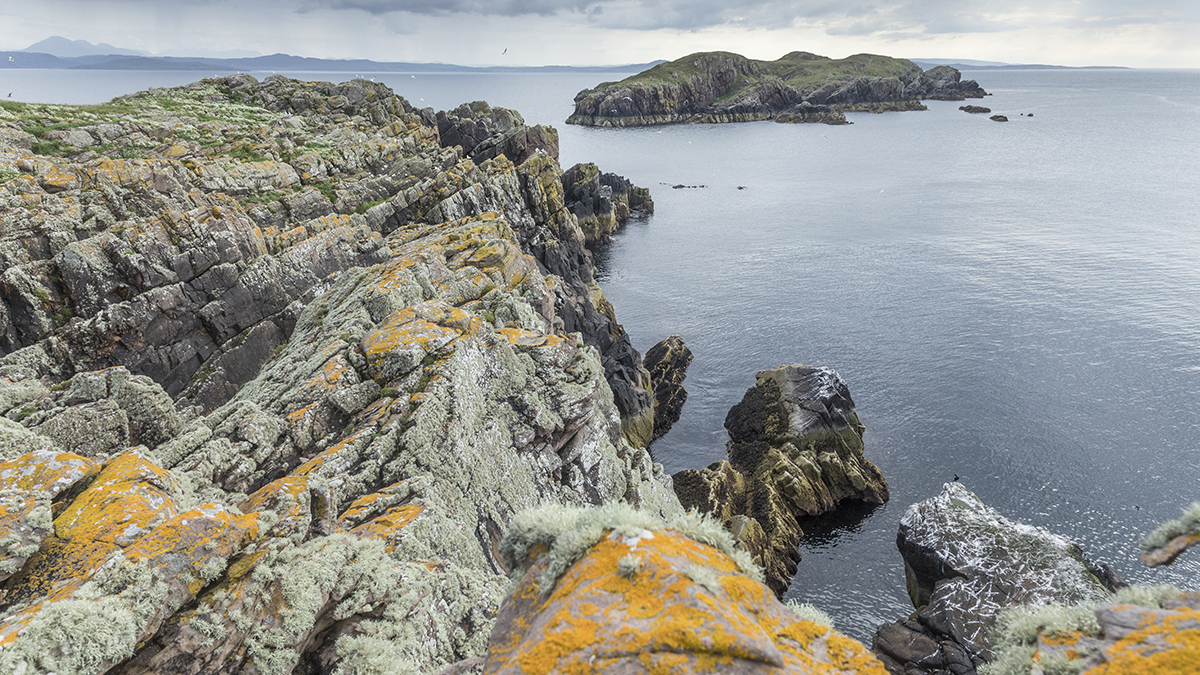 Lichens & Tar Lichen in the Splash Zone On Carn Iar
Lichens & Tar Lichen in the Splash Zone On Carn Iar
U P P E R I N T E R T I D A L Z O N E
This part of the shore is at the extreme limits of high tide and only becomes submerged for a few hours each day. What survives here has adapted to extreme changes in temperature and salinity throughout the day.
Here you might find Channelled Wrack (Pelvetia canaliculata), barnacles, limpets and periwinkles amongst other species. Barnacles may consider themselves fortunate to be the most well-endowed creature on the planet in relation to body size, interestingly they are also often found growing on whales which have the largest reproductive organ size outright. Barnacles, winkles and Limpets survive by trapping water under their shells to survive between the tides. While barnacles remain stationary, limpets can travel. They might look stuck, but underwater or on rainy days they are surprisingly active and usually will come back to their home groove between tides, see if you can spot one next time you are on the beach.
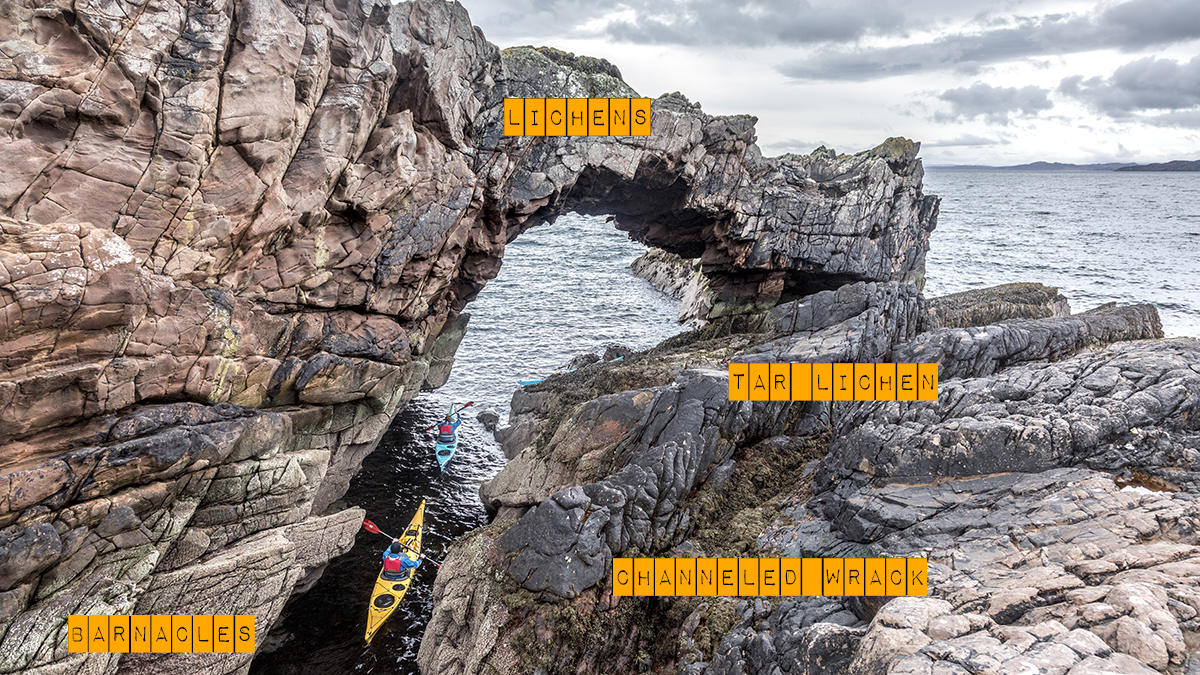 Splash and Upper Tidal Zone in the Tanera Beag Arch
Splash and Upper Tidal Zone in the Tanera Beag Arch
M I D D L E I N T E R T I D A L Z O N E
Spending roughly half of the time above and below the sea this area is dominated by brown seaweeds. As the shore life becomes more varied you might find common shore crabs, anemones, mussels and more. Species here have to be extremely well adapted to fluctuations in temperature, salinity, weather exposure and wet/dry.
Bladder wrack (Fucus vesiculosus) – One of the most predominant weeds on the beach, you will recognise it’s bubble-wrap-like floats on the fronds. These floats help seaweeds to float closer to the surface, aiding photosynthesis and gas exchange. This weed was once used as a source of iodine to treat goitres. Nowadays, you’re more likely to find it in your anti-ageing cream as research has found that it has anti-ageing properties. As you go further down the tidal zonation you might also find Serrated wrack (Fucus serratus) which looks similar but with a saw like edge to its fronds and without air sacks.
Egg/Knotted wrack (Ascophyllum nodosum) – Often found beside Bladder wrack it is easily identified by its leathery fronds with egg shaped sacks, hence the name. This weed is particularly useful to a kayaker as it tends to grow well in sheltered waters. As a general (but not total) rule of thumb large patches of Egg wrack is a good indicator of a sheltered landing.
Shore Crab (Carcinus maenas)- Shore Crabs are the most common to see on the shoreline and can grow up to 8-9cm in size. The shore crab is native to the UK, Europe and Scandinavia, and it is also Known as the European Green Crab. The species has become invasive to the USA, Sri Lanka, Red Sea, Madagascar, South Africa and Australia. It is edible (enough to have it’s very own cookbook), but not one we’d recommend in favour of the Edible Crab (Cancer pagurus) (see below).
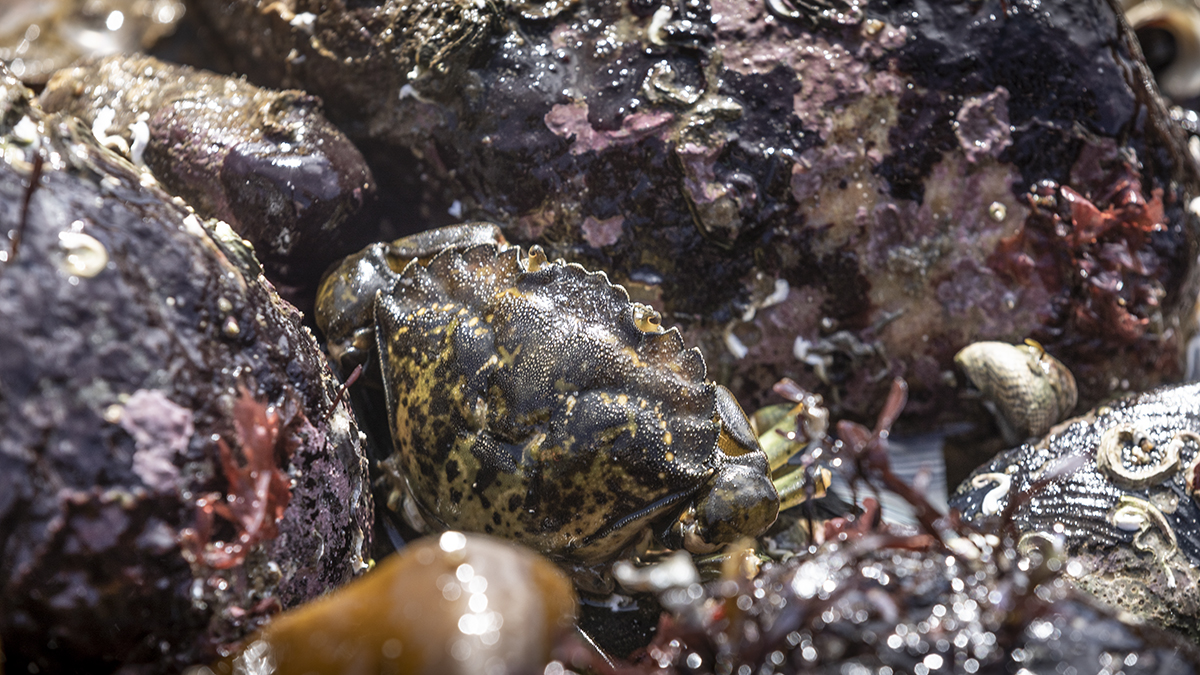 Shore Crab
Shore Crab
Fun fact * – Seaweeds, or marine algae, come in colours red, green and brown. What makes a seaweed its colour is dependent upon it’s location, pigmentation and the wavelength of available light. You might have noticed the deeper through the tide we go the seaweeds go from green to yellow to dark browns and reds. This is because the deeper into the sea we go the less light waves are available. Blue light travels the deepest (why the sea is blue), meaning that the redder the pigments in seaweed the more blue and green wavelengths they can absorb, reflecting back only red.
L O W E R I N T E R T I D A L Z O N E
The Laminarial / kelp zone is where things get really amazing as we venture closer to the realm of the sublittoral sea life. One thing we absolutely love about kayaking is being able to paddle through this zone, especially on slow spring tides, this is the border to the deeper ocean and hosts an amazing variety of species. To be honest, we could probably write a whole blog just on this zone.
Laminaria is a genus of 31 species of brown algae, commonly called Kelp. At extreme spring tides Oarweed will become visible along the shore twisting and turning on the waves. It has been used by humans for centuries for fertiliser, food and chemicals. The kelp species are a vital habitat and essential link in the food chain for many of our rarer coastal species, sadly they have recently been the source of quite some controversy as it is mass-harvested for its use in creating bio fuel and plastics leading to a welcome ban on mechanical dredging of kelp in November 2018. There are currently many wildlife trusts working with fishermen, researchers, politicians and local people towards a vision of ‘Living Seas’ where ongoing discussions are in place to whether and how this can be made sustainable as bio-plastics are a good step to a greener planet.
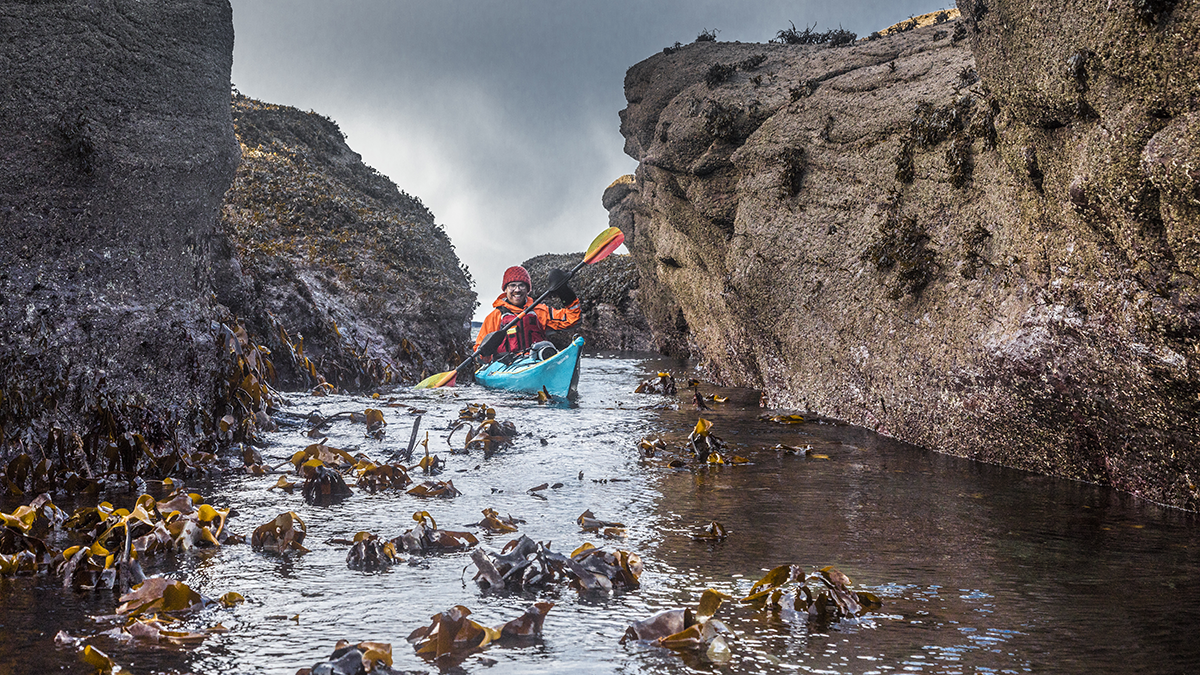 Paddling through the Laminarial zone in Annat Bay
Paddling through the Laminarial zone in Annat Bay
Carrageen: (Chondrus crispus) – Carrageen is a thin, reddish-purple seaweed, with branching fronds. It is an exceptionally tasty delicacy and our favourite edible seaweed. Since the 15th century this wonderful sea-weed has been used as a thickening agent (a good vegan alternative to Gelatin). You might have already eaten it as it is a popular ingredient in ice creams such as Ben & Jerries and used in refining wines and beers.
Blue rayed Limpet (Patella Pellucida) – Up to 20mm, these are small and hard to spot, but undoubtably one of the most beautiful species in the British Isles. Exclusively living on kelp, the Blue rayed limpet is characterised by its electric blue stripes along its shell.
Fun fact* They descend into the deeper sea during winter to escape exposure from storms.
Arctic Cowrie (Trivia arctica) – Ranging from 8-10mm these tiny yet beautiful shells are a treasure to find, we like to think they are proof that Scotland really is a tropical paradise. Fun ‘Trivia’ fact* – In the northern Scotland (particularly Caithness and Orkney) you might know these as a ‘Groatie Buckie’, Buckie coming from the Scottish word for whelks and groatie possibly from an association to money (the Scottish Groat) – other possible tangents lead to John o’ Groats where, in former times, generations of local ‘shore-sellers’ spent hours finding and selling the shells to Victorian and Edwardian era tourists. It took approximately 80 shells to make a necklace and 400-500 necklaces were sold a season at four shillings and sixpence a piece. The ‘Groatie Buckie’ is one we often find on the hidden sandy beaches in the Summer Isles, nowadays their value is in seeing them happy in the wild.
 Empty Cowrie shells found washed up on The Summer Isles beaches
Empty Cowrie shells found washed up on The Summer Isles beaches
Pycnogonida – Arachnophobes, this might not be your favourite of our listed hidden creatures. That’s right, it’s a sea spider! Good news is these amazing creatures are usually very small and difficult to find, but when you do they are almost pre-historic in appearance. (photo coming once we find one again later this year…)
Common Squat Lobster ( Galathea squamifera ) – Somewhat misleading, the common squat lobster is closer in relation to a hermit crab (which you might also find in the Laminaria). They are similar to the edible Spiny squat lobster too but miss the spiny’s vibrant orange and electric blue colours.
Edible Crab (Cancer pagurus) – A larger species from 100-200mm, this crab is famous for its edibility. The most commercially harvested species of crab in Europe, it is as recognised from the restaurant as it is on the beach.
Paddle worm (Phyllodoce spp.) – Contrary to their name, you won’t find these creatures in a kayak, but on the bottom of the kelp zone and often under rocks. These amazing creatures can be up to half a metre long and have over 700 sections. Picking these up is a big mistake as their defence mechanism is to produce copious quantities of thick clear slime…it’s grossly amazing but hard to wash off a (kayak) paddle! The paddle worms are bright green and easy to identify from the similar looking (but black) bootlace worm, also found under the rocks here.
Butter-Fish (Pholis gunnellus) – These fish get their name from their slimy, ‘buttery’ skin, if you’ve ever tried to catch one you’ll understand, but be careful as the adults can have a sharp serrated dorsal fin. They are identifiable by their brown colour and black spots. Unusually for fish, both the male and female have been observed to look after their eggs by taking it in turns to feed and guard them, somewhat like garden birds.
Blenny (Lipophrys pholis) – Also known as Shannys or sea frogs, these fish are often found in rock-pools or in damp crevices between the rocks. Consider these fish as the wise old friends of the shore as they can live for over a decade and in rare circumstances up to 15-20 years.
Sucker fish/Clingfish (Gobiesocidae). There are more than 150 species of small clingfish characterised by a strong suction cup on their underside. These have a wonderful variation in colour ranging from light yellows to browns and deep reds.
Fun fact* these suckers can hold up to 300 times their own body weight! Talk about strong!
Brittle Star (Ophiothrix fragilis) – There are several species of Brittlestar around the UK coast. They really live up to their name and can shed their arms if ever they feel threatened, so don’t touch them. Their spindly shape helps them hide between the rocks from other, larger species of starfish which predate on them.
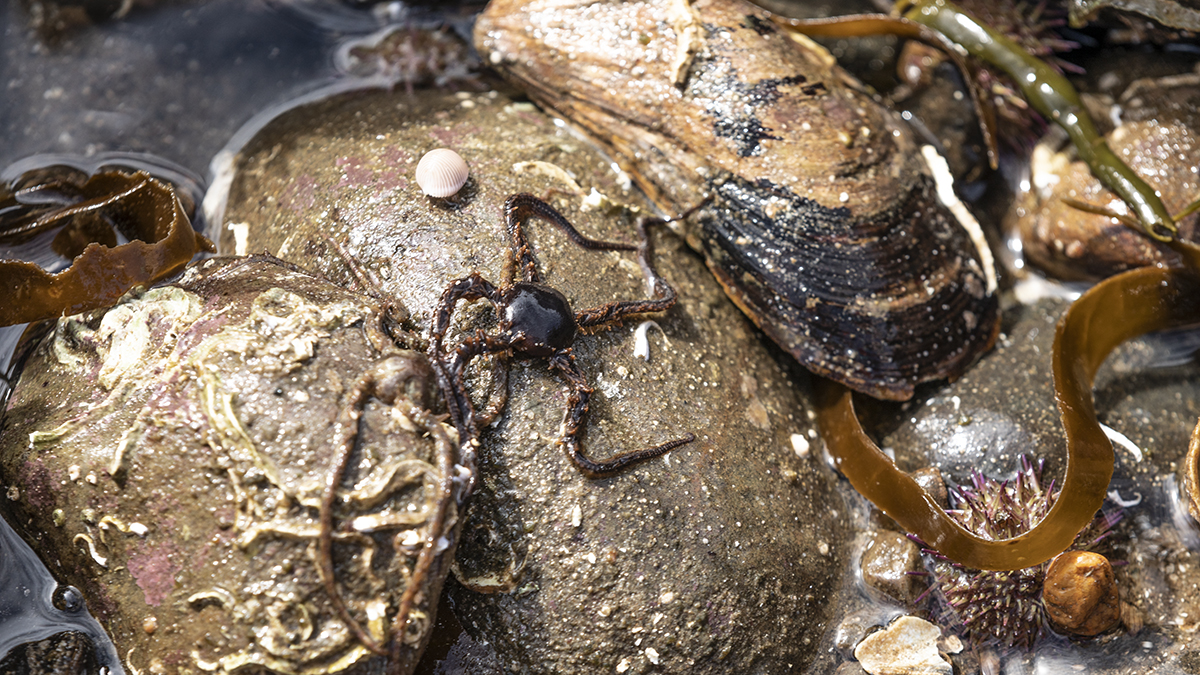 Brittle Star (and a Cowrie above)
Brittle Star (and a Cowrie above)
Seven Armed Starfish (Luidia ciliaris) – We love these bright orange coloured starfish as they are super easy to identify because, you guessed it, they have seven arms! They are a common sight in the Summer Isles and we often find them beside large common starfish and cushion stars too.
Fun fact* Starfish are amazing creatures with super healing powers, they are able to re-grow lost limbs and even fracture open their mouths to fit a bigger lump of food in. In theory, if you cut a starfish down the middle and don’t compromise its central nervous system it would regrow both sides into two genetically identical twins, cool eh! But don’t go cutting up starfish please, they are definitely much, much happier in one piece.
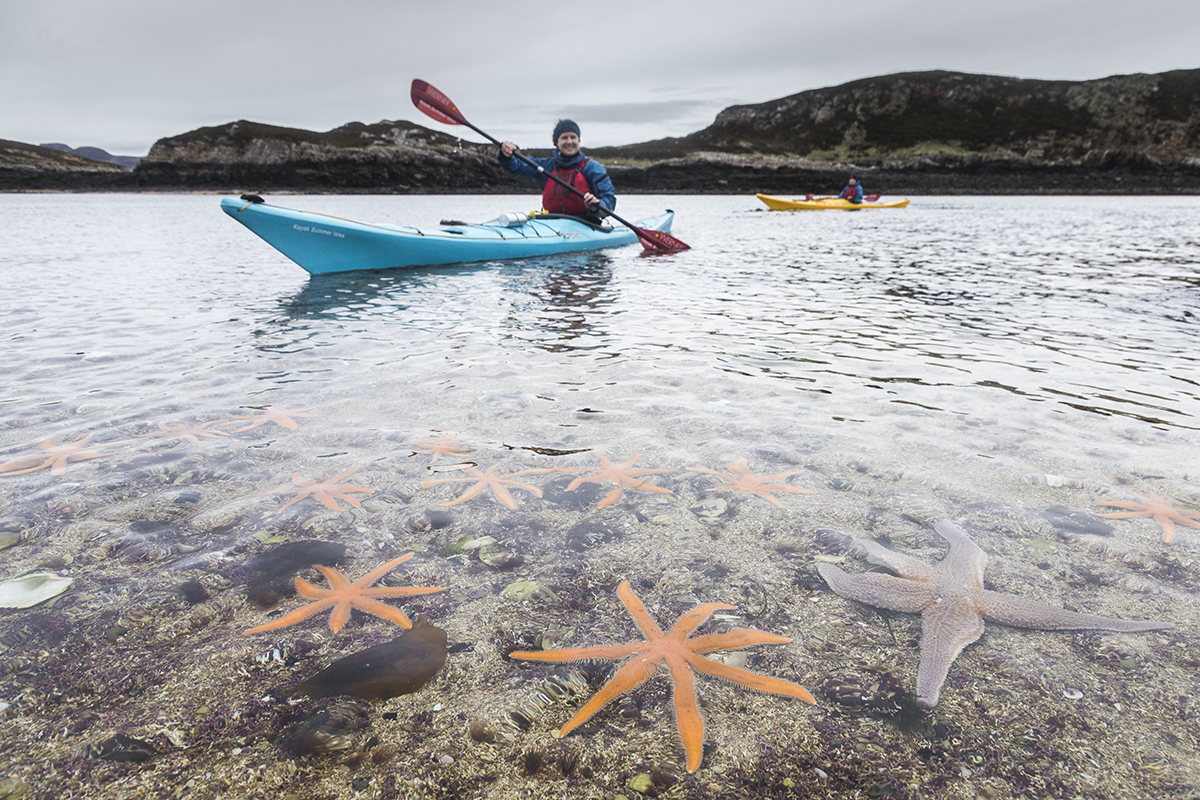 The wonders of low tide in the Summer Isles (Left /Centre – Seven Armed Starfish, Right – Common Starfish)
The wonders of low tide in the Summer Isles (Left /Centre – Seven Armed Starfish, Right – Common Starfish)
Edible Sea Urchin (Echinus esculentus) – We would be amiss not to mention the humble sea urchin, a common delight to find in the Summer Isles and shores of Loch Broom. Growing to about the size of a grapefruit, their name (Echinus) comes from the greek meaning for hedgehog, given their thousands of spines, this should come as little surprise. They are famously delicious but it is actually only the roe inside that are edible. Traditionally eaten raw, straight off the rocks, it is certainly an acquired taste and texture, not one we would personally recommend. We much prefer to leave them be and enjoy them from afar, that way the otters and sea gulls can enjoy eating them instead.
If you are starting out in shoreside exploration there are hundreds of superb resources available:
Recommended books:
Beginner – Collins Handguides – SEA COAST of Britain and Europe / ISBN: 0-00-219780-4
Intermediate – Collins Pocket Guide to the Sea Shore / ISBN: 0-00-212144-1
Advanced – Handbook of the Marine Fauna of North West Europe / ISBN 0-19-854055-8
Don’t forget to check out our friends doing great coastal things at:
SCOTTISH WILDLIFE TRUST: LIVING SEAS
And also a huge shoutout to our local heros: The Ullapool Sea Savers!
